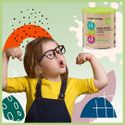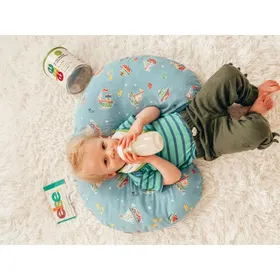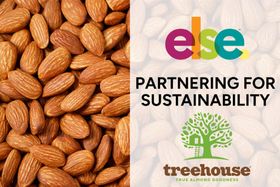How to Reduce Your Child’s Exposure to Toxins Through Their Diet
Discover how to reduce your child's toxic load from harmful chemicals found in everyday products and food
Updated August 6, 2024

Most of us are exposed to hundreds to thousands of chemicals every single day—through the food we eat, the water we drink, the air we breathe, the products we put on our skin, food packaging, and more. When it comes to toxic chemicals, the dose is what makes the poison. While we cannot totally eliminate our exposure to chemicals, we can take steps to reduce the amount—or the toxic load.
» Explore clean label, organic, plant-powered nutrition for children
Understanding Toxic Load
Toxic load is the accumulation of harmful chemicals in the body through different modes of exposure, including food, water, food additives, cosmetics, cleaning products, pesticides, and air pollution. While it may not have been as urgent a concern in the past, today, many consumers take the time to research the ingredients in products before purchasing.
Parents might especially be curious about how to protect their young children and reduce their toxic load, particularly when it comes to diet and food.
» Understand why children are more vulnerable to ingested toxins
Heavy Metals in Baby Food
Heavy metals are naturally found on Earth and can enter our food and water supplies through soil, pesticides, and food manufacturing processes. The common ones are lead, inorganic arsenic, mercury, and cadmium. Even though the amount of heavy metals found in individual foods is relatively small, the total accumulation is what can be harmful to infants and young children.
» Ensure your baby formula contains no harmful ingredients
Recent investigations into popular baby food brands reported that 95% of tested products contained at least one of the heavy metals at too high of a dose. According to the Pediatric Environmental Health Specialty Units (PEHSU), a young child’s total heavy metal exposure can pose a risk to health, especially for the rapidly developing brain, in turn potentially negatively impacting their learning, attention span, and behavior.
Minimizing Children's Exposure to Heavy Metals
At the moment, there are no regulations for heavy metals in baby food, except for arsenic. The Food and Drug Administration has proposed the Closer to Zero Plan to regulate all four common heavy metals levels in baby food, but this won’t be implemented for some years.
In the meantime, according to the American Academy of Pediatrics, these steps can help parents minimize their children’s exposure as much as possible.
- Replace rice and rice-based foods (like cereals or puffs) with other grain alternatives, such as oats, barley, quinoa, bulgur, couscous, and others. Rice naturally tends to be higher in inorganic arsenic.
- Stick to whole, minimally processed foods when purchasing or consider making baby food at home.
- Serve a variety of nutrient-dense foods to avoid concentrated doses of specific foods. Sweet potatoes and carrots, both commonly used for baby foods, tend to contain higher levels of heavy metals.
- Avoid packaged commercial fruit juices, which tend to contain higher levels of heavy metals. Instead, opt for water or milk for hydration and whole fruits or homemade fruit purees.
- Be cautious of the type of fish you eat. Larger fish tend to be contaminated with higher levels of heavy metals like mercury.
- Check your water supply and other parts of your home (such as wall paint) for levels of lead.
» Discover nutritious plant-based formulas tested to be safe from heavy metals, toxins, and other nasties
Per- and Polyfluoroalkyl Substances (PFAS)
Also known as “forever-chemicals,” PFAS are manmade chemicals found in many things, including water, food containers, waterproof clothing, nonstick cookware, and more.
Data suggest that most people in the U.S. have some of these chemicals in their bodies. PFAS can stay in the human body for many years, and their exact impact on health is still under study. However, they’ve been associated with adverse health effects in both adults and children.
To reduce a child’s exposure to PFAS:
- Check drinking water levels for PFAS. Some filtration devices may help in reducing their level in water.
- Avoid food products with packaging that contains PFAS and opt for whole, minimally processed foods in the diet.
» Avoid PFAS with clean, plant-powered formulas made with whole, minimally processed ingredients
Bisphenol A (BPA)
BPA is a chemical found in polycarbonate plastics. They are abundant as they’re used in so many products. BPA is found commonly in water bottles, canned foods, and food packaging—thus, it can leach into our food and water supply, especially at high temperatures.
There is no known level of BPA that is considered safe or harmful, but there is a concern about the health effects of exposure, especially in infants and young children.
To lessen a child’s exposure to BPA, parents can take these steps:
- Opt for BPA-free, glass, porcelain, or stainless steel bottles and containers over plastic.
- Avoid microwaving plastic food containers to reduce leaching.
- Reduce the use of canned food products when possible.
» Opt for clean, plant-based nutrition that prioritizes your child's health
Key Points: Research, Access to Info, and Demand Transparency
As with all things, access to information and education are key to making informed decisions. When deciding how to better care for a child’s health, parents can also opt to purchase products that meet higher standards of purity from contaminants.
References
- FDA, Closer to Zero: Action Plan for Baby Foods
- One Green Planet, Baby Foods Contain 40 Times More Heavy Metals than Vaccines, and Parents Should Be Concerned
- Blythedale, How to Reduce Toxic Load & Prime the Body to Better Handle Toxins
- PEHSU, Heavy metals in baby foods and fruit juices
- Consumer Reports, Most Baby Foods Contain Arsenic, Lead, and Other Heavy Metals, Study Finds
- Healthy Children, Heavy Metals in Baby Food
The content and advice provided in this article are for informational purposes only and are not a substitute for medical diagnosis, treatment, or advice for specific medical conditions. Always consult a pediatrician to understand your child's individual needs.










